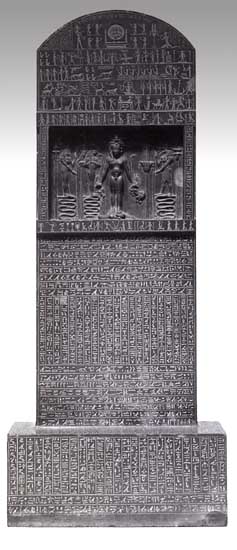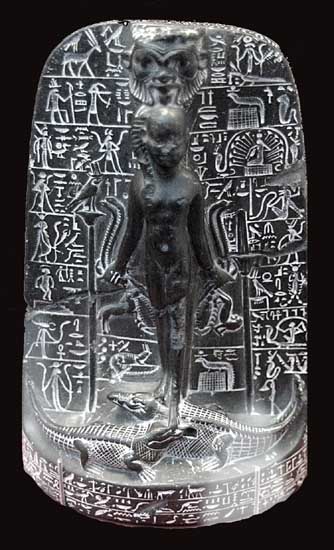An essential feature of the
incantations was that the patient must be identified with a god
and particularly with Horus, and so cause the malign forces to
reconsider the gravity of what they had done. The most complete and least corrupt
version of the texts is found on the unique and extremely
elaborate Metternich stela in the Metropolitan Museum of Art in
New York. It was commissioned by the priest Nes-Atum in the
reign of Nectanebon, the last pharaoh of the 30th Dynasty,
immediately before the second Persian conquest in 343 BC.
Nes-Atum was an ancient Egyptian antiquarian and went to very
considerable trouble to collect the best available texts from
cippi and from the burial place of the Mnevis bulls in
Heliopolis. His selection of texts was then engraved with
meticulous care on a fine block of dark green greywacke,
standing almost one metre high and covered on all sides with
text. Following the usual pattern of a cippus, the upper part of
the front has a panel carved in high relief showing the child
Horus standing on the backs of crocodiles, grasping various
noxious animals, while attendant deities are shown standing on
snakes, all demonstrating their triumph over the powers of evil. Horns has been stung. 0 Ra; your son
Horus has been stung who is without sin.

The top half of this stela was skilfully carved in a hard dark
stone. On the part below the central figure panel, rows of
hieroglyphs record thirteen magic spells to protect against
poisonous bites and wounds and to cure the illnesses caused by
them. The stela was commissioned by the priest Esatum to be set
up in the public part of a temple. A victim could recite or
drink water that had been poured over the magic words and images
on the stela. As a mythic precedent, the hieroglyphic
inscription around the base describes the magic cure that was
worked upon the infant Horus by Thoth, the god of wisdom and
writing.
On the stela Isis speaks and recounts that while she and Horus
were still hiding in the marshes, the child became ill. In her
despair, she cried for help to the "Boat of Eternity" (the sun
boat in which the god travels over the sky), "and the sun disk
stopped opposite her and did not move from his place." Thoth was
sent from the sun boat to help Isis and cured Horus by reciting
a catalogue of spells. The spells always ended with the phrase
"and the protection of the afflicted as well," indicating that
by using these spells, any type of affliction in human beings
would be healed.
In this detail of the stela, Horus emerges from the background
in such high relief that he is posed as an actual
three-dimensional statue, with his left leg striding forward and
his head directly facing the viewer. He is portrayed in the
conventional Egyptian form for youth; that is, he is nude and
wearing his hair in a side lock. The soft, rounded forms of the
bodies of Horus and the other deities are typical of the style
of the period.
To symbolize his magic powers, Horus holds snakes and scorpions
as well as an antelope (by its horns) and a lion (by its tail)
in his closed fists. His feet rest on two crocodiles. Above him
is the head of Bes, the dwarf deity with leonine features who
had traditionally protected households but by this time had
become a more general protective deity. Horus is flanked by
three deities who stand upon coiled snakes. On the right is
Thoth, identified by his ibis head, and on the left is Isis.
Both protectively hold the walls of a curved reed hut, a
primeval chapel, in which the Horus child stands together with a
figure of Re-harakhty, god of the rising sun, and two standards
in the form of papyrus and lotus columns. The lotus standard
supports the two feathers of Osiris's headdress.
The images incised into the stone at the top of the stela
portray the perilous night-time journey of the sun as it passes
through the nether world under the earth. Its rebirth each
morning is shown at the uppermost point of the stela, where
Thoth, four baboons, and the kneeling King Nectanebo II lift
their arms in the gesture of adoration and prayer. Nectanebo II
was the last indigenous king of ancient Egypt. He struggled
valiantly against the Persian empire only to be defeated in the
end. After the lost battle, he fled to Upper Egypt, and nothing
is known about his end.
 A
cippus of the late period showing the child Horus exhibiting
mastery over dangerous and venomous animals. As usual the
head of Bes appears over Horus and this example, from the
British Museum, is embellished with names and representations of
various gods and goddesses - including Serqet. There is
also extensive text on the back, sides and base.
A
cippus of the late period showing the child Horus exhibiting
mastery over dangerous and venomous animals. As usual the
head of Bes appears over Horus and this example, from the
British Museum, is embellished with names and representations of
various gods and goddesses - including Serqet. There is
also extensive text on the back, sides and base.
Many shrines in both temples and homes in the Late Period of
ancient Egypt contained stelae known as cippi which were
believed to confer protection from attack by certain animals,
particularly snakes, scorpions and crocodiles. A typical cippus
shows Horus-the-Child, with side lock, standing on the backs of
crocodiles, holding a variety of dangerous animals and thus
symbolising his victory over malign forces. In this guise he was
known as Horus-the-Saviour.
Cippi provided a range of texts and incantations which could be
recited both for prevention of attack and for relief in the
event of a sting or bite. The effect of the incantation could be
reinforced by the application of water which had been poured
over the stela, thereby absorbing its magical texts and scenes.
The incantations inscribed on a cippus were necessarily
abbreviated and drawn from a body of texts which have features
in common with the Pyramid Texts of the Old Kingdom. Thus, for
example, Pyramid Text Utterance 378 says:
The back of the Metternich stela contains the remarkable story
of Isis, Horus and the scorpion, which provides the basis for
most incantations against scorpion stings. It describes how Isis
set out one evening accompanied by seven scorpions whose names
were known to her and who had been assigned for her protection.
Isis and her entourage were refused entry at the first house
they encountered. The indignant scorpions conferred and then
transferred all their venom to their leader, Tefen, who then
stung the son of the mistress of the house. Isis hastened to
massage the throat of the child and called upon the poison of
Tefen to come forth from the child.
The story is then interrupted in order that those who might need
to use the incantation can be instructed how to relate a
stricken child to Isis' son Horus and so to proclaim:
May the child live and the poison die. As Horus will be cured
for his mother Isis, those who suffer will be cured likewise.